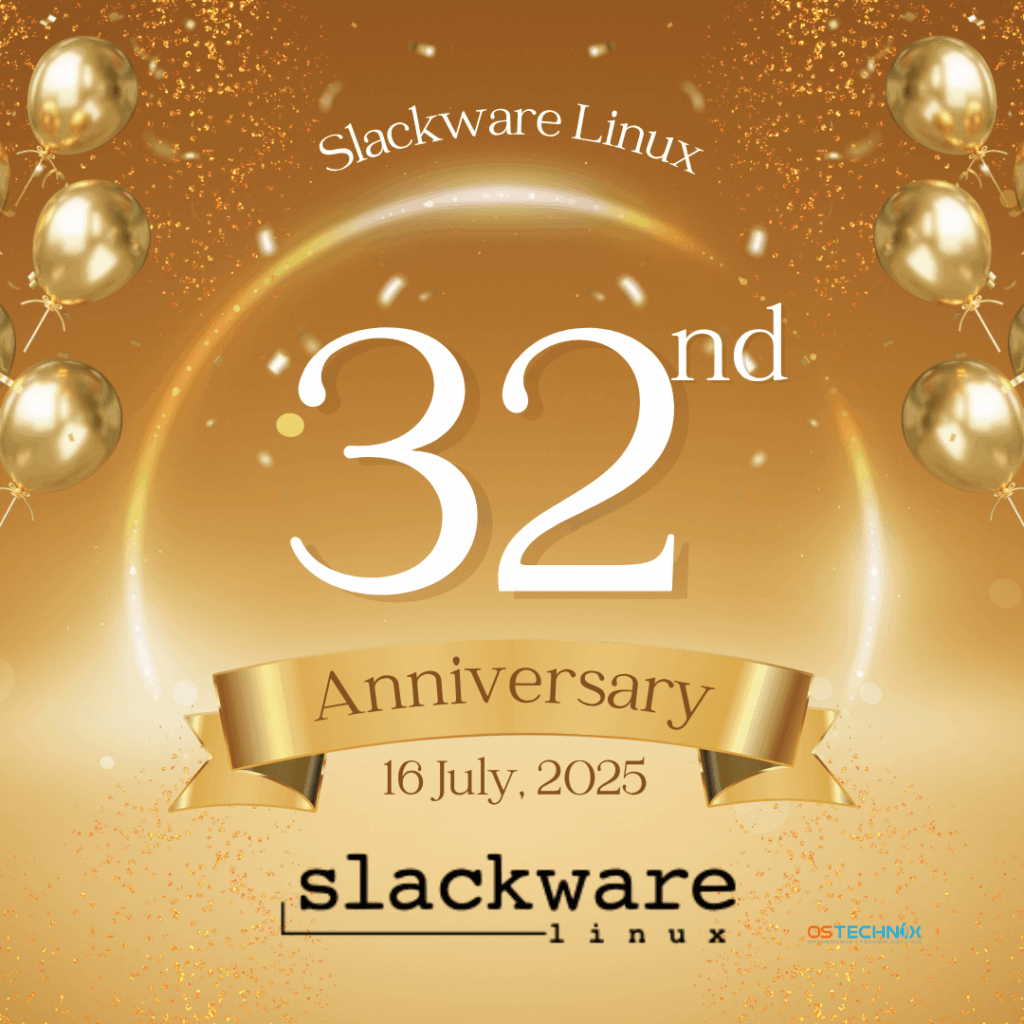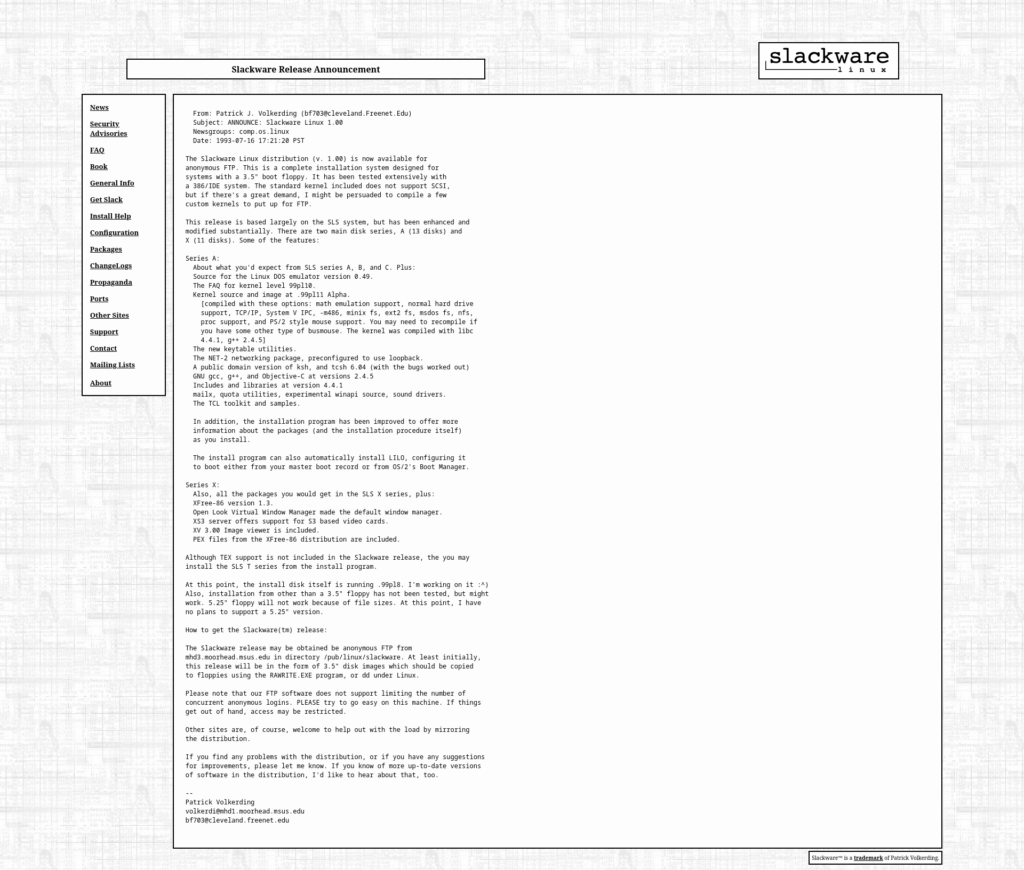This is a great distribution which I ran for over a year as my main OS in the the early 2000’s. Though, you eventually reach a point that you want fuller repositories and less compiling. But it was extremely stable. These days I prefer Arch or Debian for big repositories, with Arch getting the nod for more up to date packages, and AUR with scripts for easily compiling additional software that are packaged for Arch with better system integration. And AUR has come in handy recently for using the XLibre X11 packages on my Arch laptop. But congratulations to Slackware for 32 years of Linux goodness.
https://ostechnix.com/celebrating-slackware-linux-32nd-anniversary/
Slackware’s Enduring Legacy: 32 Years of Linux Stability
By sk
Yesterday, 16 July 2025, is a truly special day in the history of open source software. It was the 32nd anniversary of Slackware Linux, a name that resonates deeply with anyone who appreciates stability, simplicity, and a hands-on approach to computing.

For me, it’s not just an anniversary; it’s a celebration of an operating system that truly changed the landscape and continues its steadfast journey.
The Birth of Slackware
The story of Slackware began in late 1992 with Patrick Volkerding, affectionately known by many as “The Man” and Slackware’s “Benevolent Dictator for Life” (BDFL).

Patrick, who earned his BS in Computer Science in 1993, first encountered Linux when seeking an affordable LISP interpreter.
He started using SLS Linux from Soft Landing Systems, but like many early adopters, he found himself fixing bugs as he went along.
Eventually, he decided to merge all his bug fixes into his own private distribution for himself and his friends.
This personal project quickly gained popularity, leading Patrick to name it Slackware and make it publicly available.
Official Announcement for Slackware Linux 1.00
The official announcement for Slackware Linux 1.00 was made on 16 July 1993, though it was “initially released to the world on July 17, 1993”.

This launch heralded the beginning of what is now known as the oldest Linux distribution still maintained.
Right from the start, Slackware aimed to make things easier for users by introducing a user-friendly installation program based on a menuing system.
Patrick also pioneered the concept of package management, allowing users to effortlessly add, remove, or upgrade software on their systems.
The Enduring Philosophy: Simple, Solid, Slackware
What truly sets Slackware apart and explains its remarkable longevity is its core philosophy. As the saying goes, it’s “Still simple. Still solid. Still Slackware”.
Slackware distribution does not attempt to mimic Windows; instead, it strives to be as Unix-like as possible.
This means you won’t find fancy, point-and-click graphical user interfaces (GUIs) covering up processes. Instead, Slackware puts you, the user, firmly in control, allowing you to see exactly what’s happening beneath the surface.
Its development process is equally distinctive: versions are not rushed to meet deadlines; instead, “each version comes out when it is ready”.
This commitment to readiness over arbitrary dates is a significant factor in Slackware’s renowned stability and simplicity.
It has earned a strong reputation as a solid server and a no-nonsense workstation, powering businesses and serving in nearly every capacity a server can.
The People Behind the Slackware Project
While Patrick Volkerding is the founder and BDFL, Slackware’s journey has also been shaped by other dedicated individuals. For instance:
- David Cantrell worked full-time on Slackware for several years, handling the SPARC port, technical support, testing, and new package development. He also developed the
autoslackandprotopkgutilities. - Chris Lumens also dedicated several years full-time to the project. He was responsible for porting Slackware to the Alpha platform (known as Slackware64™) and played a significant role in the Slackware Linux Essentials book, including its formatting. Chris also contributed to PHP and MySQL projects.
A Legacy That Changed Lives
For many users, Slackware wasn’t just another operating system; it was a foundational experience.
Numerous users recall it as their very first Linux distribution, describing it as “hard AF for total newbie” but incredibly rewarding, making them “feel like a total hacker”.
Imagine the dopamine hit of discovering the startx command to load KDE3 without easy internet access, or installing a modem driver entirely from the console.
These challenging but formative experiences created lasting memories, with some users stating that Slackware and Linux “totally have changed my life – for better or worse”.
Even though the original 1.0 release is largely considered “lost to time” with only the beta and 1.01 versions known to exist, its impact is undeniable.
Conclusion
Slackware isn’t for everyone, but it continues to attract those who “enjoy learning and tweaking their system to do exactly what they want”.
Its stability and simplicity are why people will continue to use it for years to come. And speaking from experience, I can tell you that Slackware users are truly among the most satisfied Linux users.
Here’s to many more years of this incredible, enduring Linux distribution!